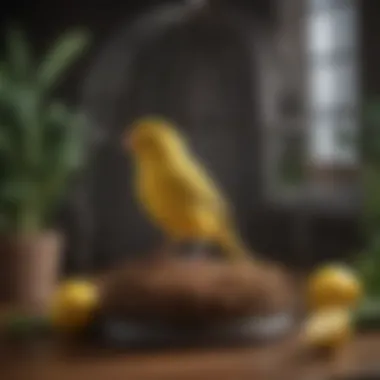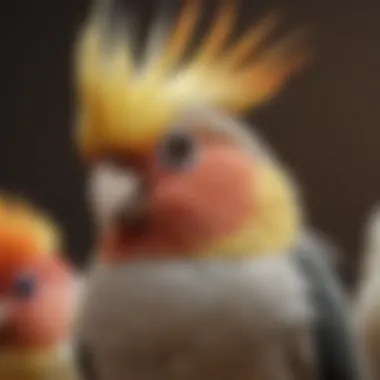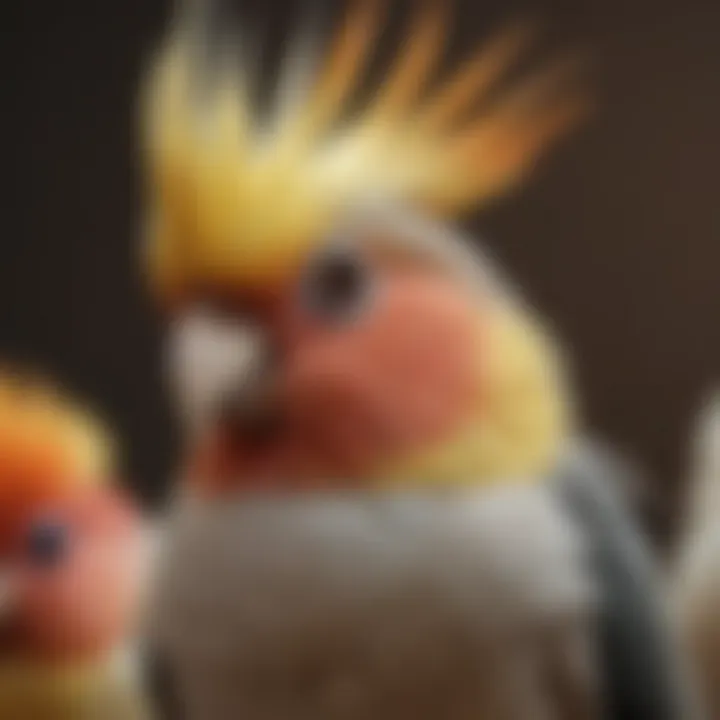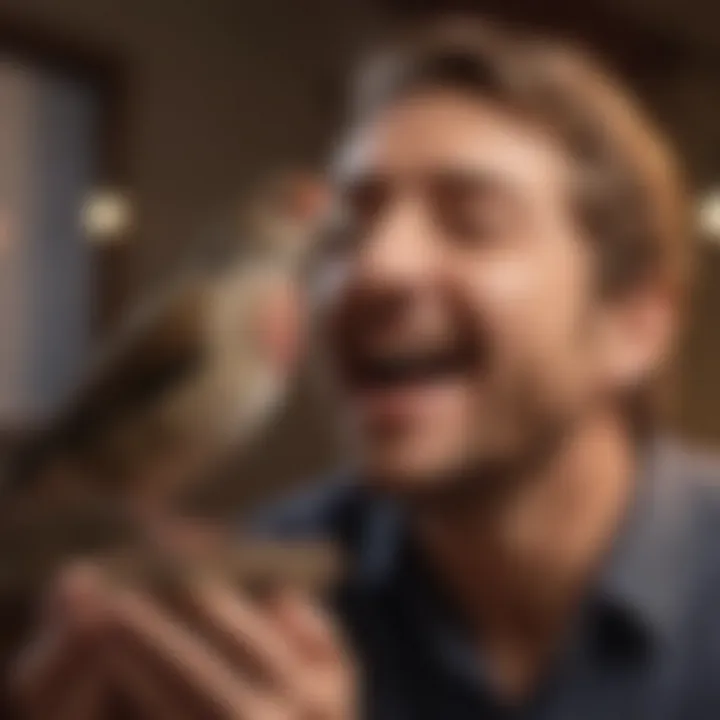Exploring the Joy of Singing Pet Birds


Intro
Singing pet birds can bring joy that resonates far beyond the boundaries of their small cages. It's almost magical how their melodies can brighten up a mundane day or offer comfort during times of solitude. When we think about these vibrant creatures, we often envision not just their colorful feathers but also the intricate sounds they create—each tweet and trill tells a story. This exploration invites pet bird enthusiasts, both seasoned and new, to embark on a journey through the auditory delights of our feathered friends.
An inspiring bond forms when human and bird connect through song; it’s a link built on understanding and shared experiences. Birds communicate in myriad ways, and recognizing the nuances of their vocalizations adds another layer of appreciation and involvement in avian care.
The realm of singing pet birds encompasses much more than mere sound. One must also consider elements like nutrition, habitat, and emotional well-being, all of which heavily influence a bird's vocal performance.
In this guide, we aim to uncover the full spectrum of joy that singing pet birds can offer, offering insight into their world, emphasizing how we can nurture their gifts, while also highlighting the profound emotional connections that flourish through song.
Defining the Experience of Singing Birds
The experience of singing birds captures a unique blend of nature and companionship, serving as a beacon of joy for many pet owners and bird enthusiasts alike. It’s not merely about having a feathered friend; it’s about shared moments and the rich interactions that arise from daily life among these charming creatures. Understanding what makes this experience notable can deepen one’s appreciation and connection with these avian buddies.
Understanding Bird Song
Birdsong serves as a form of language for our feathery companions, a medium for expression that conveys their thoughts, feelings, and even social standing. Each species brings its own flavor to the table—canaries render sweet, melodious tunes while cockatiels show off with playful whistles. The significance of their singing goes beyond mere entertainment; it reflects their well-being and engages their natural instincts.
It brings to mind the image of a bustling café where chatter fills the air. Just as humans gather to express joy through conversation, birds come together in song. Their vocalizations play a central role in their social interactions, from mating calls to establishing territories. Every note is like a brushstroke on a canvas, portraying the excitement and complexities of avian life.
To unravel this, one must consider how different factors, such as mood and environment, impact their vocal performance. A relaxed bird, for instance, might belt out more melodious notes, while one under stress may fall silent.
The Role of Vocalization in Avian Life
Vocalization is a cornerstone of avian behavior, serving numerous functions that help them thrive in their surroundings. For many bird species, these vocal expressions forge essential social bonds. Mated pairs might engage in duets to reinforce their partnership, while flocks communicate through varied calls, ensuring cohesion as they navigate their habitat.
These sonic cues can also alert birds to potential threats. A sudden shriek might signal an approaching predator, leading others to action. Even within a simple chirp lies the richness of communication, revealing the sophisticated social fabric of bird culture. Moreover, vocalization plays a role in mating rituals. Males often sing to attract females, showcasing their vitality and genetic fitness.
Birds, like humans, thrive on connection. In fact, research has suggested that birds with a more active singing life tend to showcase better overall health.
"The song of a bird encapsulates its spirit and serves as a vehicle for connection, signaling the reality of life in every chirp and trill."
Thus, fostering a singing environment not only enhances the lives of birds but also strengthens the bonds between them and their human caretakers. It encourages interaction and fosters an emotionally rich atmosphere where song becomes a shared experience, enriching both bird and owner alike.
The Psychology of Birds and Singing
The connection between pet birds and their ability to sing is not merely a coincidence; it is a profound reflection of their emotional states and social structures. Understanding the psychology of birds and singing unravels layers of complexity in their behavior and interactions with their environments and caretakers. This section will explore how birds express their feelings and navigate their social settings through their enchanting songs.
Emotional Expression Through Sound
Birds are creatures rich with emotional expression, and their songs serve as a primary means of communication, encapsulating their inner experiences. Just as humans might hum a tune when happy or sing a melancholy ballad when feeling low, birds utilize their melodies to denote a spectrum of emotional states. A bright chirp could indicate excitement, while a softer, more somber tune might signal distress or loneliness.
These vocalizations can be influenced by various factors, including their surroundings and the presence of their caregivers. For instance, a parakeet might belt out a cheerful tune when it feels safe and comfortable in its environment, signaling joy or even playfulness. Conversely, in times of fear or discomfort, a bird might produce irregular, erratic sounds to express agitation.
Moreover, research suggests that a bird's well-being is deeply intertwined with its vocal expressions. A pet bird that sings frequently often indicates a healthy and thriving emotional state. Encouraging an environment that fosters such expressions can strengthen the bond between bird and owner. Positive feedback – like gentle praise or even mimicking – might motivate them to sing more readily.
Social Dynamics Explained
Understanding the social dynamics of avian singing unveils how these creatures engage with one another. In the wild, songs are essential tools for establishing territory, attracting mates, and forming social bonds within flocks. For pet birds, these dynamics translate into their interactions with their caregivers and fellow housemates.
When kept in groups, birds often adjust their vocal patterns, responding to each other’s calls. This could manifest as duets or call-and-response sequences, showcasing a unique aspect of avian social behavior. For example, finches may harmonize their songs, creating a melodious symphony, symbolizing unity.
Integrating social aspects into their vocal training can be beneficial as well. When birds interact with their companions or even their human families, they may display more varied and enthusiastic singing. Hence, ensuring your bird has social opportunities is crucial. This harmony can be achieved with:
- Regular interaction with owners
- Introducing companion birds for socialization
- Encouraging play and bonding activities
As bird caregivers, focusing on these social dynamics can lead to a richer, more fulfilling life for both the bird and its human companions. The relationship becomes not just about owning a pet but coexisting with a lively creature that brings music into the home.
"Birdsong is the ancient language of birds seeking joy, connection, and expression. It reminds us that we are part of a larger world, connected through sound and shared experiences."


As we derive immense pleasure from their singing, understanding the underlying psychological factors not only enhances our interaction but also promotes a healthier and more vibrant environment for these remarkable creatures.
Popular Singing Bird Species
The world of pet birds captivates many enthusiasts, and among the most alluring aspects are the singing species that fill our homes with delightful melodies. This section explores the most popular singing birds, their unique qualities, and what makes them so appealing to bird lovers. Understanding these species takes us a step closer to recognizing their individual charm and the joy they can bring to our lives.
Canaries: The Melodious Favorites
Canaries are often the first name that comes to mind when one thinks of singing birds. Their vibrant colors and sweet songs have charmed people for generations. Known for their lively and rich vocalizations, these small birds have a natural ability to produce varied notes and tunes. The singing ability of a canary is often linked to its breed; for example, the Belgian Blue is particularly famous for complex melodies.
These birds thrive in a well-cared-for environment, enjoying a diet rich in seeds, fruits, and vegetables. Canaries exhibit a fascinating behavior; males are the primary singers, often competing with each other during the breeding season to attract mates. This aspect of their singing is not just for show; it reflects their health and vitality. For canary enthusiasts, encouraging this singing can become a rewarding experience, creating a unique bond.
Nightingales: Nature's Lyricists
Nightingales are renowned for their extraordinary vocal prowess. These birds, much larger than canaries, are capable of producing an impressive range of sounds that include melodious notes and intricate patterns. Originating from Europe, nightingales are often associated with romantic imagery, thanks to their enchanting songs that serenade through the night.
What makes them stand out is not just their vocal skills; it's the emotional depth in their singing. Nightingales often sing to declare territory, courting partners, or simply to express themselves. Observing a nightingale belt out its tunes can evoke profound feelings in listeners, bridging the gap between human emotions and avian expressions.
Budgerigars: Charming Conversationalists
Often affectionately known as budgies, these small parrots are more than just colorful companions. Budgerigars are social birds, known for their entertaining chirps and ability to mimic sounds, including human speech. Their sociability makes them excellent companions, often forming close bonds with their owners.
With a bit of patience, many budgie owners report success in teaching their birds to talk, making the interaction even more enjoyable. Their natural curiosity and playful demeanor also contribute to their engaging presence. Feeding them various seeds, fresh fruits, and the occasional treat can heighten their singing and mimicry, making them a joy to interact with.
Cockatiels: Whistlers with Personality
Cockatiels are incredibly interactive and charming, known not just for their whistles but for their lively personalities. They can create a myriad of sounds, from soft chirps to distinct whistles that resemble tunes from popular songs or even catchphrases. Their ability to imitate sounds can be quite impressive, earning them a reputation as the entertainers of the avian world.
Their vocal talents often emerge in response to environmental cues, including the voice of their owners or sounds from the television. This responsiveness creates a delightful atmosphere in any home, making interactions both enjoyable and memorable. A happy cockatiel will often sing or whistle spontaneously, brightening the room with its joyful presence.
To truly appreciate the essence of these singing birds, one must understand not only their biology but also the emotional connections they forge with their human companions.
Factors Influencing Bird Vocalization
Understanding the elements that shape how pet birds vocalize can significantly enhance both the experience for the owners and the well-being of the birds themselves. Singing is not just a pleasant sound; it’s a crucial part of avian communication. Various factors come into play, affecting how vocalizations manifest, from environmental influences to health conditions. By grasping these elements, bird owners can create an enriching environment that encourages singing, thereby nurturing a deeper bond with their feathered companions.
Environmental Stimuli
The surroundings in which a bird resides hold a substantial role in dictating their vocal behavior. Birds, being creatures of habit, thrive on a stable yet stimulating environment. Factors like room acoustics, lighting, and even the presence of mirrors can influence how often and how well a bird sings.
- Light Exposure: Birds are sensitive to daylight cycles. Frequent exposure to natural light during the day can promote more cheerful melodies. Conversely, insufficient light may lead to lethargy, which can dampen their spirits, affecting their vocalization.
- Sound Environment: Birds are great mimics and often mimic sounds they hear around them. From the rustle of leaves to the hum of conversations, rich soundscapes can inspire birds to explore their vocal potential. A radio playing soft music or nature sounds can provide both a comforting and stimulating backdrop.
- Companionship: If birds can see or hear other birds, it may inspire them to sing. Whether it's chirping from a nearby window or the songs of wild birds outside, social cues play a crucial role in vocal engagement.
Health and Well-Being
The physical state of a bird directly influences its desire to sing. Healthy birds tend to express themselves more freely. Factors such as nutrition, exercise, and mental stimulation are paramount in ensuring your bird is in the right shape to belt out those tunes.
- Nutritious Diet: A well-balanced diet enriches a bird's health and, consequently, its voice. Species like budgerigars and canaries require specific vitamins and minerals to maintain their vibrant singing capabilities. Poor nutrition can lead to a decrease in energy and vocalization.
- Regular Check-Ups: Just like humans, birds require routine health assessments. Illness can suppress their instinct to sing. A fine-tuned avian health regimen ensures that your feathered friend stays chirpy.
- Physical Activity: Birds are naturally active and require room to flight or play. When they have the chance to stretch their wings and engage in play, their overall happiness increases, leading to more vibrant singing.
Breeding Season Behavior
The breeding season serves as a critical time for many birds, triggering heightened vocalization, as it is part of their natural mating rituals. Understanding these instincts can help owners anticipate changes in their birds’ behaviors and vocal habits.
- Increased Singing: During courting, male birds often ramp up their singing to attract mates. It is vital to honor this instinct by providing a suitable environment that promotes courtship behaviors, such as larger cages or specific perches.
- Establishing Territory: Singing can also signal territory for many species. Males may sing louder and more frequently during this period to fend off intruders and showcase their strength. This innate behavior contributes not only to the birds' repertoire but also to their emotional well-being.
- Nesting Preparations: With breeding often come nesting behaviors. Birds may sing differently during this time, expressing their excitement and readiness. Providing elements like nesting boxes can enhance their comfort, thus influencing their vocal expressions.
It’s clear that by paying close attention to the various factors influencing bird vocalization, we can foster a joyful environment where our avian companions thrive.
By addressing these essential aspects, owners can build an enriching, supportive environment that encourages vocal expression, ultimately augmenting the joy they share with their singing pet birds.
Creating an Inspiring Singing Environment


Creating an environment that fosters singing in pet birds is crucial to their well-being and vocal happiness. Birds in a stimulating atmosphere often sing more and exhibit enthusiastic behavior. A well-thought-out space provides a balance of comfort and stimulation that encourages vocalization. In this section, we will explore essential elements, benefits, and considerations regarding setting up a conducive environment for your feathered friends.
Cage Setup Considerations
When setting up a bird's cage, think of it as a miniature home that must replicate some aspects of the natural environment. Choosing the right cage size is paramount. Birds need space to stretch their wings, move around, and explore. A cage that's too small might lead to stress and reduced singing. Opt for cages that are wider than they are tall, allowing birds to move side to side more comfortably.
The layout inside the cage is just as important. Incorporate perches of varying sizes and textures. Natural wood perches are preferable since they mimic the trees where many birds find themselves in the wild. However, platform perches can also be a great option for resting and play. Additionally, placing toys and foraging items within easy reach can lure birds to interact and engage, promoting spontaneous vocalization as they play.
Moreover, pay attention to ventilation and light. A well-lit cage that allows for natural light can boost a bird's mood and stimulate singing. However, it's a tightrope walk; direct sunlight can also be harmful. It is better to position the cage near a window where the light is filtered through a sheer curtain.
Audio Enrichment Techniques
Birds, like humans, appreciate a rich audio environment. Mimicking nature through sound can significantly enhance a bird's singing experience. Consider introducing soft classical music, which many birds respond well to. This background sound can encourage them to vocalize more freely. Additionally, streaming sounds of rain forests, chirping crickets, or even the calls of their species can capture their interest.
Creating a routine will further reinforce this enriching environment. Playing bird songs or nature sounds at regular intervals can cue your bird to join in the vibrant chorus. For instance, start your day by playing serene morning sounds and watch how your pet bird might begin to sing along.
Here are a few effective techniques for audio enrichment:
- Use bird-specific apps that replay songs of various avian species.
- Rotate different genres of music to see what resonates with your bird.
- Engage your birds with sounds that mimic their calls to playfully invite them to join the conversation.
Encouraging Interaction and Play
Birds are social creatures by nature, and interaction plays a vital role in their happiness and vocalization. Encouraging play should be a priority in every bird owner's routine. Engaging with your bird daily—whether through talk, interaction, or simple games—can lead to an increase in singing.
Try joining your bird in playful activities. Simple games like hide-and-seek with toys or gentle games of tag will create bonds and encourage them to vocalize. Having interactive toys that require the bird to solve a small puzzle can also enhance their mental engagement.
It's essential to allow for some unscheduled free play outside of their cage, too. Setting up a bird-safe play area with perches, climbing structures, and hanging toys can make quite a difference. This space encourages your bird to move around freely, explore, and express itself vocally.
“Birds who play together, sing together.”
This old saying highlights the essence of fostering interaction. Make it a habit to have quality time with your pet, reinforcing the message that singing is not just heard but truly appreciated.
In summation, creating an inspiring singing environment is less about perfection and more about your commitment to cultivating a joyful atmosphere. By thoughtfully setting up their spaces, providing enriching audio, and promoting interaction, you can turn your home into a symphony of delightful bird songs.
Training Techniques for Enhancing Singing
Teaching your pet birds to sing can be a rewarding journey, both for you and your feathered friends. This aspect is crucial, as the ability to enhance a bird's natural vocalization not only elevates their spirits but also strengthens the bond you share. By employing specific training techniques, you can inspire your singing pet bird to express itself more freely and melodiously. While every species has unique characteristics, tailored training methods can still yield marvelous results.
Positive Reinforcement Strategies
At the heart of effective bird training lies the principle of positive reinforcement. This approach rewards your bird for desired behaviors, creating a motivating atmosphere that encourages further progress. Here’s why it matters:
- Building Trust: Positive reinforcement instills confidence in your bird, making it feel safe and secure in your presence.
- Creating Motivation: By associating singing with rewards, you entice your bird to perform its best vocalizations.
- Encouragement for Interaction: This method promotes engagement, inviting your bird to connect with you during training sessions.
For example, when your canary chirps a tune, a gentle "Good job!" coupled with a favorite treat can drive home the idea that singing leads to happy outcomes. Stick to small rewards like millet or fresh fruits, as these can be easily given during training. You'd be surprised how quickly your pet will catch on!
- Start with short sessions, gradually extending their length as your bird becomes more comfortable.
- Celebrate the small victories. This might be a single note sung perfectly or even just an attempt at a tune.
- Be patient! The process can take time, and one bird might learn faster than another.
"The best training sessions are filled with encouragement and fun. Your bird won’t just learn to sing; it will flourish under your care."
Mimicking and Teaching Methods
Mimicking is one of the most effective methods for teaching birds to sing. In many ways, birds are like us—they learn by listening and replicating. Here are some insightful tips to navigate this technique:
- Recordings of Bird Songs: Play high-quality recordings of your pet bird's natural songs or those of similar species. Regular exposure helps develop their auditory skills.
- Modeling by Owner: Sing or whistle around your bird. By imitating the sounds you want them to learn, you set a practical example they can follow. The key is consistency; carve out time daily to interact vocally.
- Engage in Repetition: Repetition is your ally. The more your bird hears a melody, the more likely it is to mimic that song. Try singing the same tune several times during your training, using a clear pitch and rhythm.
Short, engaging sessions filled with joyous repetition can work wonders. Think of yourself as the conductor—lead your bird through a delightful symphony of sound.
To sum up, the combination of positive reinforcement along with mimicking techniques creates a fertile training ground. Your singing pet bird not only becomes a talented vocalist, but uplifting your training methods will also nurture a deeper relationship between you and your avian companion. Embrace the joy of this process!


The Benefits of Birdsong to Humans
Birdsong offers more than just pleasant melodies drifting through the air; it serves as a bridge connecting humans with their feathered companions on multiple levels. The way these melodies resonate can enhance not only the lives of our pet birds but also enrich the emotional and cognitive lives of their owners. It's fascinating how simple chirps, whistles, and trills can evoke a range of responses, from relaxation to inspired creativity. This section will delve into these benefits, highlighting how the songs of pet birds have a profound impact on human experience.
Cognitive Enhancements
Birdsong might seem like mere background noise, but recent studies suggest that it can actually boost cognitive function. Listening to birds chirping has been linked to improved concentration and heightened focus. For instance, when trying to work from home or study, the gentle sounds may help drown out other distractions, creating an atmosphere conducive to productivity.
- Auditory Engagement: Engaging with bird songs can enhance auditory processing skills. This engagement may sharpen listening abilities, which is particularly beneficial for individuals who teach or work with children.
- Memory Stimulation: The melodic nature of birdsong can trigger memories associated with particular tunes or species. This connection can aid in retaining information better, a handy trick while learning about different bird species or studying related topics.
- Creative Inspiration: Many artists, writers, and musicians often turn to natural sounds, like birdsong, as sources of inspiration. Several well-known pieces of literature reference the ethereal quality of these sounds, showcasing how they can stimulate creativity.
In essence, the varied tones and pitches that birds create can open the mind in versatile ways, encouraging deeper thoughts and novel ideas.
Emotional and Psychological Impact
The impact of birdsong on emotional well-being is profound, often acting as a balm for stress. The soothing sounds evoke a feeling of calm, reminiscent of tranquil nature environments. Through various studies, it has been shown that individuals exposed to these melodic sounds display lower levels of anxiety and improved mood. Engaging with birds and their songs can lead to positive psychological outcomes such as deeper emotional connections and reduced feelings of isolation.
"Surround yourself with life and sound; the smallest melodic gesture can create the largest emotional shift."
- Stress Reduction: Listening to the gentle trill or warble of a singing bird can significantly lower cortisol levels, the stress hormone, promoting a sense of tranquility. This is particularly beneficial in our fast-paced world.
- Bonding Experience: Birdsong can facilitate bonding not just between pet and owner, but also among family members. Shared appreciation for a bird’s vocal prowess can transform mundane moments into cherished memories. By taking time to simply listen to a bird sing, families can increase their interactions and strengthen their collective joy.
- Therapeutic Benefits: Animal-assisted therapy often incorporates the positive effects of interacting with pet birds. The simple act of watching or listening to a singing bird operates as a therapeutic method, creating moments of joy amidst any trials one's dealing with.
Birdsong serves as a reminder of the beauty of life, fostering connections that may not be possible through mere words.
In summary, the benefits of birdsong extend well beyond entertainment. They hold the potential to enhance cognitive abilities and improve emotional well-being, resulting in a multi-dimensional relationship that enriches the lives of both birds and their human caregivers.
Cultural Significance of Birdsong
Birdsong weaves a rich tapestry in the culture and history of humanity. The melodies of our feathered friends resonate deeply within many societies, forming a bridge between people and nature. These vocalizations do more than entertain; they foster connections that enhance emotional well-being, inspire creativity, and even influence cultural practices. In this section, we will explore how birdsong manifests in art and literature, as well as how historical contexts give depth to our understanding of avian music.
Birdsong in Art and Literature
Art and literature have often found inspiration in the sweet serenade of birds. For centuries, poets and artists have laid their hearts bare, using birdsong as a metaphor for longing, freedom, and love. Take, for instance, John Keats’s poems, where the nightingale symbolizes pure beauty, undying love, and nature's voice.
- Many famous artists have portrayed singing birds, capturing their essence through brush and canvas. Their work often reflects the idea that these creatures are not just aspects of nature, but carriers of emotional depth.
- In music, compositions range from classical symphonies incorporating bird calls to contemporary songs celebrating their charm. Listening to a piece inspired by birdsong can invoke vivid imagery, connecting listeners with feelings of nostalgia and yearning.
Birdsong has dual significance—while it represents that direct connection to nature, it also invites human emotion and interpretation.
"Birdsong is the poetry of the earth; each note expresses a profound unseen emotion."
Historical Perspectives on Avian Music
A look back through history reveals how vital birdsong has been to societies across the globe. In many ancient cultures, birds were seen as messengers of the gods or omens of events. Indigenous tribes often considered the songs of birds essential to their rituals and ceremonies. The vibrant songs of certain species were said to usher in good fortune or enhance harvests.
Birdsong also played a role in daily life, serving as a marker of time. Most people understand the chirping that heralds dawn or the evening lullabies as nature’s clock. In farming communities, such sounds were pivotal signals for sowing and harvesting, directly affecting livelihood.
In modern times, the fascination with birdsong persists. There are initiatives aimed at preserving the soundscapes of various environments, acknowledging both the ecological and cultural importance of these melodies. Conservationists strive to maintain habitats that allow birds to flourish, ensuring future generations can continue to experience and cherish these sounds.
End: The Shared Joy of Singing
The experience of enjoying singing pet birds transcends mere sound; it weaves a narrative of connection and emotion between human and bird. This conclusion underlines the importance of this relationship, exploring how it fosters bonds that are both profound and enriching.
Reinforcing Bonds Through Song
Birdsong is more than just a melody; it serves as a powerful means of communication. For pet bird owners, engaging with their feathered friends through singing can strengthen the bond between them. Birds like budgerigars and canaries have been observed imitating their owners, weaving a dialogue that is truly unique.
- Shared Interaction: When owners sing, they invite their birds into an interactive experience. This exchange can be as simple as chirping a tune or repeating a catchy phrase. Each note exchanged helps to reinforce trust and familiarity.
- Emotional Connection: The emotional impact of singing is profound. It often elicits immediate responses from birds, showcasing their joy or excitement. This, in turn, can evoke feelings of happiness and contentment in owners, deepening their emotional ties.
- Behavioral Influence: Singing can also influence a bird's behavior positively. This communication may lead to less stress and anxiety in birds, enabling them to thrive in their environments. Owners observing their birds responding playfully to songs can experience joy that reinforces the importance of nurturing these relationships.
The Future of Bird Interaction and Singing
As we gaze into the future, the interaction between birds and their owners may evolve further, thanks to ongoing research in avian behavior and communication. Here are some points to consider:
- Advancements in Understanding: With newfound insights into bird vocalizations and emotions, pet owners can learn more effective ways to interact with their singing companions. Every chirp or note is now seen as a flicker of a bird's personality.
- Technological Integration: Apps for bird song training and enrichment may become integral tools for new bird parents. Such innovations could help in understanding the nuances of their birds' songs, encouraging a healthier environment for vocal expression.
- Community Engagement: Online forums and discussion platforms like Reddit can play a significant role in the future dynamics of bird ownership. As bird keepers share experiences and tips on enhancing bird song, a collective knowledge base may flourish, creating a community rich in insight and support.
"The joy of singing with pet birds is not merely in the sound they produce, but in the connections we develop through shared experiences."
In essence, the shared joy of singing with pet birds symbolizes a mutual appreciation. The melodies they produce and the joy they elicit draw together a special bond filled with understanding, warmth, and affection. Bird owners not only uplift their avian companions but also enrich their own lives through this melodious engagement.















